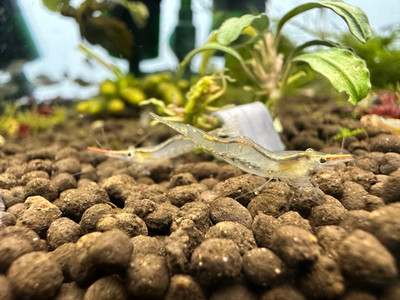Pinocchio Shrimp (Caridina gracilirostris)
Posted by Max Gandara on on 30th Oct 2024
Pinocchio Shrimp (Caridina gracilirostris): A Guide to Care and Compatibility
The Pinocchio Shrimp, also known as the Red-nose Shrimp or Rudolph Shrimp, is a unique freshwater shrimp species prized for its slender body and distinctive long, red rostrum (nose), which gives it the “Pinocchio” nickname. Known for their gentle, active nature, these shrimp make lively and entertaining inhabitants of planted aquariums. However, they have particular requirements that aquarists should meet for them to thrive. Here’s everything you need to know about keeping Pinocchio Shrimp, including tank setup, diet, and suitable tank mates.
Origin and Natural Habitat
Scientific Name: Caridina gracilirostris
Place of Origin: Southeast Asia, including areas of Thailand and the Philippines
Pinocchio Shrimp are native to brackish estuaries, coastal streams, and freshwater rivers throughout Southeast Asia, where they inhabit environments with a mix of freshwater and slight salinity. In the wild, they are often found among aquatic vegetation, where they feed on biofilm, algae, and other organic particles. As they’re adapted to slightly brackish conditions, these shrimp can tolerate a range of water parameters, though they still require specific care to do well in a home aquarium.
Physical Characteristics and Behavior
Pinocchio Shrimp are named for their long, thin red rostrum, which extends forward from their heads. This “nose” is an unusual and charming trait that sets them apart from other shrimp species. Their bodies are transparent with a hint of red or pink, and they typically grow to about 1.5–2 inches in length. Known for their active behavior, Pinocchio Shrimp are constantly on the move, exploring their surroundings and grazing on surfaces in search of food.
These shrimp are peaceful and social, thriving in groups of 5 or more. They are generally hardy but require stable conditions to remain healthy.
Setting Up the Aquarium
Creating a comfortable environment for Pinocchio Shrimp involves careful attention to water quality, aquascaping, and tank maintenance.
- Tank Size: A minimum of 10 gallons is recommended for a group of Pinocchio Shrimp. Larger tanks help maintain water stability.
- Water Parameters: While Pinocchio Shrimp can tolerate slightly brackish conditions, they are adaptable to freshwater, provided it is stable and clean.
- Temperature: 72–78°F (22–26°C)
- pH: 6.5–7.5
- Water Hardness: Moderately soft to moderately hard (4–12 dGH)
- Salinity: These shrimp can thrive with a low amount of salt (1–2 grams per liter) but can be kept in freshwater as well.
- Filtration and Water Flow: Use a gentle, shrimp-safe filter, such as a sponge filter, to avoid strong currents and ensure safe filtration.
- Decorations and Substrate: Pinocchio Shrimp feel most comfortable in a planted environment with plenty of hiding places, such as rocks, driftwood, and aquatic plants like Java moss and ferns. These plants also provide surfaces for biofilm, an essential food source for shrimp.
Diet and Feeding
Pinocchio Shrimp are omnivores, primarily grazing on biofilm, algae, and organic matter. A varied diet helps maintain their health and keeps them active and thriving.
- Primary Diet: High-quality shrimp pellets and algae wafers formulated for Caridina species provide balanced nutrition.
- Supplements: Blanched vegetables (such as spinach or zucchini) and occasional powdered foods or algae-rich supplements can support a varied diet.
- Feeding Frequency: Feed small amounts once a day, taking care to remove any uneaten food within a few hours to prevent water quality issues.
Tank Mates for Pinocchio Shrimp
Pinocchio Shrimp are peaceful and best suited to community tanks with other small, non-aggressive species. Here are some compatible tank mates:
- Other Shrimp - Other peaceful shrimp species, such as Amano Shrimp, Bamboo Shrimp, and Neocaridina species (e.g., Cherry Shrimp), can coexist well with Pinocchio Shrimp.
- Small, Peaceful Fish - Tiny, gentle fish such as Ember Tetras, Harlequin Rasboras, and Celestial Pearl Danios are usually safe and non-threatening.
- Snails - Snails like Nerite Snails, Malaysian Trumpet Snails, and Mystery Snails are peaceful tank mates and contribute to algae control.
- Otocinclus Catfish - These small, algae-eating catfish are safe for shrimp and add to the community’s peaceful environment.
Avoid larger or more aggressive fish, as they may stress or harm the shrimp. Fish that are known to nip at small tank mates or have predatory tendencies should not be kept with Pinocchio Shrimp.
Breeding and Lifecycle
While breeding in captivity is possible, it can be challenging, as Pinocchio Shrimp larvae typically require brackish water to develop successfully. They spawn in freshwater, but the eggs need brackish conditions to hatch and for larvae to grow. For those interested in breeding, setting up a separate brackish tank is necessary to support larval development.
Common Challenges in Keeping Pinocchio Shrimp
- Water Sensitivity: Pinocchio Shrimp can be sensitive to fluctuations in water parameters. Stable pH and clean water are essential to prevent stress and disease.
- Reproduction Requirements: Due to their brackish water requirements for larvae, breeding Pinocchio Shrimp can be more complex than breeding typical freshwater shrimp.
- Finding Suitable Tank Mates: Careful selection of tank mates is important, as these shrimp are easily stressed by larger, active, or aggressive fish.
- Diet and Grazing Needs: Providing biofilm and a variety of foods ensures they meet their dietary needs, which can require more attention in newer tanks where biofilm is not yet established.
Conclusion
The Pinocchio Shrimp’s playful behavior, distinctive appearance, and unique requirements make it an intriguing and rewarding choice for aquarists. While their brackish water needs may pose challenges for breeding, these shrimp adapt well to freshwater aquariums with stable, gentle conditions and minimal tank mates. Their peaceful nature and fascinating appearance make them a beautiful addition to any planted tank or dedicated shrimp setup. With the right care, Pinocchio Shrimp will add vibrant life to aquariums, delighting aquarists with their charming presence.

